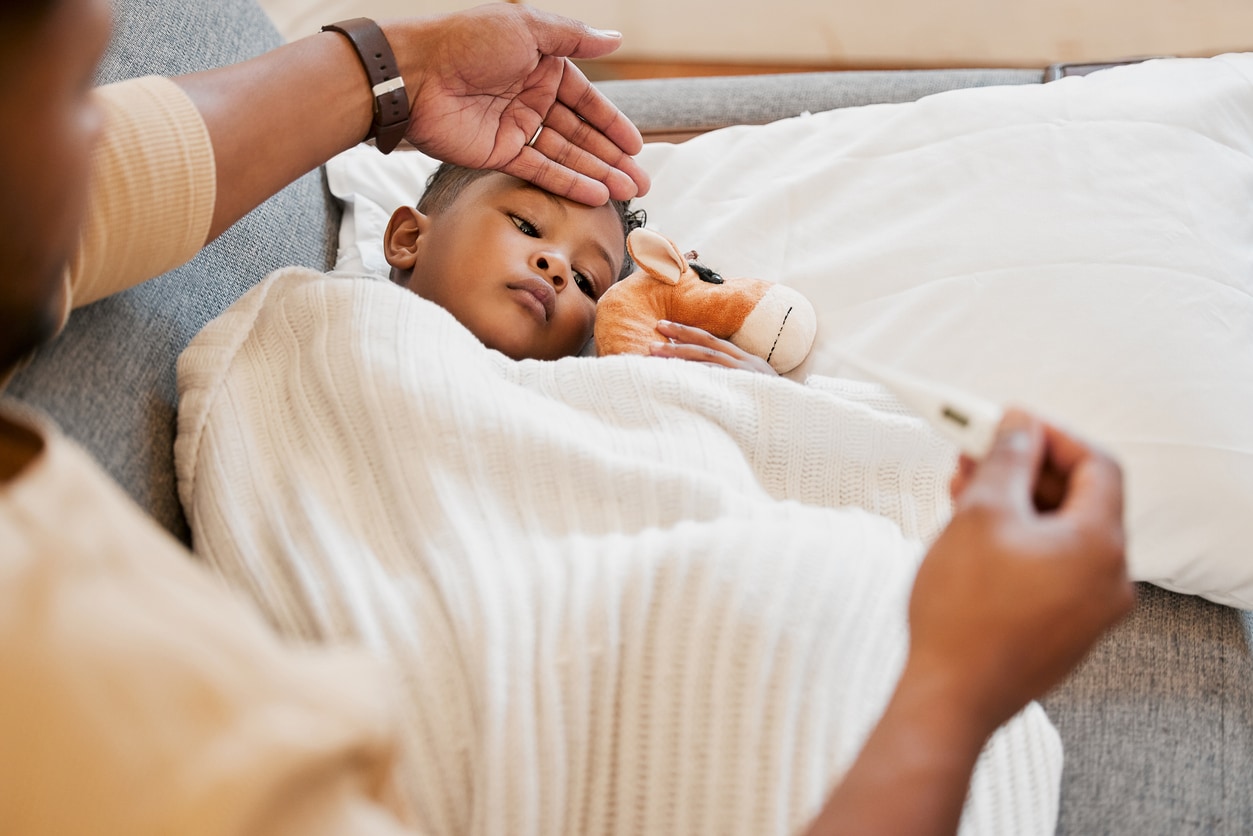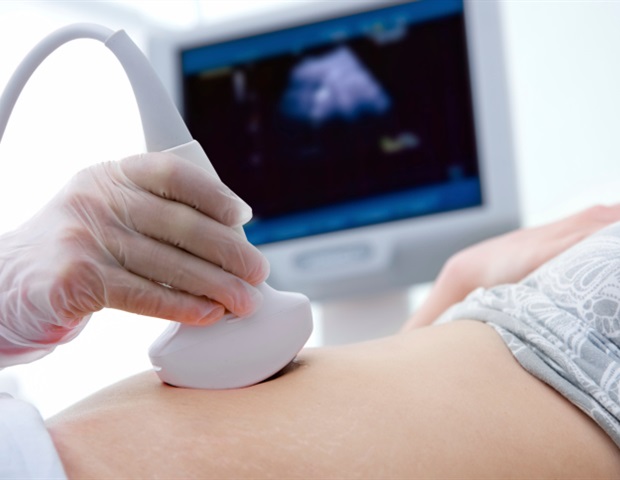You pick your baby up from a nap and feel the heat radiating from them like a space heater on full blast. Your heart sinks. Perhaps your stomach clenches with worry. Your baby has a fever. Fever in babies can feel scary when you don’t know the cause.
Some fevers need attention immediately, like a fever in babies or fevers over 105 degrees Fahrenheit in older children. Non-urgent fevers in babies tell you their body is fighting off a minor infection. To know how to handle a fever, you need to know how to measure it, monitor it, and treat it.
What is a Fever?
Your immune system raises the temperature when your body fights off an infection. The heat from a fever supercharges your immune cells, slows down the invading germs, and generally helps your body defeat the infection.1
What is Considered a Fever in Babies?
A baby has a fever if their internal temperature reaches 100.4 degrees Fahrenheit. If your baby is younger than three months old and has a fever of 100.4 or higher, this is a medical emergency, and your provider may advise you to take them to the emergency room immediately.2
If your baby is over three months, you can usually treat it at home, although it’s always a good idea to consult a pediatrician. If their fever reaches 105 degrees Fahrenheit, inform your healthcare provider or take them to the ER.
Causes of Fever in Babies
Infection remains the most common cause of fevers in babies. However, if your baby feels hot to the touch or has a “low-grade” fever, they may not have an infection but something more temporary. An increase in temperature can come from:3
These fever-causing situations can resolve quickly. In the case of overdressing, simply taking a layer or two off can lower your baby’s temperature in a few minutes. After a vaccine or during teething, a slight temperature may hang out for a day or two.
How to Take a Baby’s Temperature
You have several options for measuring your baby’s temperature, though research has suggested some techniques are more accurate than others. And it’s important to note that some methods give you slightly higher or lower results than others.10
Rectal

Buy Here
Parents may feel squeamish about taking their baby’s temperature rectally, but this method gives the most accurate result in very young children.4
To take a rectal temperature, follow these steps:5
- Use a digital thermometer labeled for only rectal use.
- Apply lubricating jelly – found at any pharmacy – to the tip of the thermometer and your baby’s anus.
- Gently push the thermometer in ½ inch to 1 inch. For babies under six months, use the ½-inch measurement.
- Wait until it beeps, then record your result.
It’s essential not to push the thermometer too far because it can poke a hole in the baby’s rectum. Some rectal thermometers are specifically designed to go into the proper depth. Whether you measure the depth yourself or use a special device, use caution. If you feel resistance, stop.
Ear

Buy Here
You will use a tympanic thermometer to take the temperature in your baby’s ear. These can be used in children older than six months: Any younger and their ear canal is too small.5
To take a temperature with a tympanic thermometer:
- Pull your child’s ear back (up and back if under one year old) and insert the probe.
- Some manufacturers ask you to press the button before, some after. Follow the package instructions for this part.
- Aim the probe tip between the opposite eye and ear, then wait for the beep.
If your baby has an ear infection, they may not like this very much. If they act extremely fussy when you try this, you can opt for a different method.
Armpit

Buy Here
The armpit temperature has been a standard for parents for decades, but research has shown it isn’t very accurate.5
To take a temperature under the arm:
- Using a digital thermometer, press the button and wait for a beep.
- Place the tip of the thermometer at the center of the armpit and firmly lower your child’s arm over it.
- Wait for the beep, then note the results.
If you decide to use an armpit reading, remember to take the result as more of a general screening and not a precise measurement.
Forehead

Buy Here
Temporal thermometers measure the heat waves coming from an artery just under the skin of the forehead. To use this method, you will want to read the manufacturer’s instructions, as they can differ slightly from one another.5
Generally, you will follow these steps to take a temporal temperature:
- Activate the device by pressing a button.
- Swipe the device from the center of the forehead to either temple, then slide over and behind the ear. (This step will vary from model to model.)
- Note your results.
Non-contact infrared skin thermometers have grown in popularity since the Covid-19 pandemic began, but researchers are still a bit iffy on their accuracy.6
Temperature Differences Between Methods
Different temperature methods can give you slightly different results. You will get different results if you measure the same baby’s temperature rectally, orally, in the armpit, and on the forehead (poor baby!). General guidelines are that the average normal oral temperature is 98.6 degrees Fahrenheit. Rectal and ear temperatures are between 0.5 degrees to 1 degree higher, while armpit and forehead temperatures are often 0.5 degrees to 1 degree lower than the average oral temperature.7
Let’s look at an example. Your baby girl woke up feeling warm and acting fussy. You take her temperature in her armpit, which is at 99.1 degrees Fahrenheit. If you had taken it orally, the result would have been 100.1 degrees. A rectal temperature would have shown a fever of 101.1.
If you feel unsure of your baby’s temperature reading and are concerned about their symptoms, call your pediatrician, and they can advise you on the next steps.
Signs of Fever in Babies
Fevers don’t feel good. You can attest to that if you’ve had one as an adult. Your head may hurt, your muscles may ache, and you can feel cold as an iceberg one moment but as hot as fire the next. Your baby feels all these things, too, and they will show it. Common signs of fevers in babies include:2
- Extra sweatiness
- Doesn’t want to eat or drink
- Feels warm to the touch
- Flushed skin
- Irritable and fussy
- More quiet and calm than usual
Rarely, fevers can cause seizures in young children. If this happens, call your pediatrician or 911 right away. Most febrile seizures resolve quickly without any complications.7,8
What To Do When Your Baby Has a Fever
You have measured your baby’s temperature; as you suspected, they have a fever. Now what? You can treat the symptoms of fevers or the fever itself, but remember that fever does serve a purpose, so you don’t necessarily want to jump to treatment immediately.
Treatment of Fever in Babies
If your baby gets so miserable that you must act, you can treat a fever in several ways. Your pediatrician may recommend you give the baby acetaminophen or ibuprofen to reduce fever symptoms.2
Pay close attention to dosing on the bottle, or your provider may give you a dosing chart. Never give your baby aspirin. It can cause a severe complication called Reyes Syndrome.9
Tips and Tricks for Baby Fevers
If you don’t want to medicate your baby yet or at all but still want to help them feel more comfortable, here’s how to reduce fever in babies naturally:2
- Dress your baby in light clothing.
- Let the baby soak in a room-temperature bath.
- Put cold washcloths on the forehead, wrists, and groin, changing them out as they get warm.
More recent studies have called into question the practice of giving babies cold baths, as research shows they don’t work well and can further distress the baby. Dressing lightly can also cause problems if your baby starts shivering. You know your little one best, so feel out how they’re doing, and you can adjust as needed. If you have questions, call your pediatrician.4
When to Call Your Healthcare Provider
Some parents want to know when to worry about fever in babies. Others think, “I’m always worried!” The list below can help you decide when to call for help.
Newborns
For newborns up to three months old, you must follow different rules than older babies. Call your pediatrician right away if your newborn displays any of these symptoms:2
- Baby doesn’t wet a diaper in 12 hours.
- They can’t swallow anything and are drooling.
- They’re difficult to wake up.
- They are having difficulty breathing even after you clear their nose.
- Their crying is inconsolable.
- They look or act very sick.
- They have purple spots on the skin.
- Their rectal temperature is higher than 100.4 degrees Fahrenheit.
- They have a stiff neck.
These signs may mean your child needs rapid treatment, so don’t hesitate to take them in or call for help.
Fever Symptoms That Need Immediate Attention
Fevers in older babies and children can occasionally call for medical care outside your home. Let your provider know if your older baby or child has any of the following symptoms.2,7
- Burning or pain with urination
- Fever for more than 24 hours with no obvious cause
- Fever of 102 degrees or higher
- Fevers that come and go for up to a week or more
- A new rash or bruises
- Other symptoms that suggest an illness may need to be treated, such as a sore throat, earache, or cough
If your baby has a medical illness like a heart problem, diabetes, or a weakened immune system because of illness or treatment, you will want to inform their provider about a fever sooner. If your baby has recently gotten a vaccine or brought them outside the country, your provider will also want to know.
Fever in babies can feel alarming. The best thing you can do for them is to keep an eye on it and try to keep them comfortable. Treat their symptoms but try and let that fever do its thing. Give your baby all the extra snuggles, and this, too, shall pass.
Sources
1. https://academic.oup.com/9/1/26/5998648
2. https://www.childrenshospital.org/
3. https://www.sciencedirect.com/pii/S0262407920307314
4. https://www.mdpi.com/2227-9067/4/9/81
5. https://www.healthychildren.org/
6. https://www.tandfonline.com/doi/10.1080/03091902.2017.1409818
7. https://www.mountsinai.org/
8. https://www.healthychildren.org/
9. https://www.ninds.nih.gov/
10. https://www.stanfordchildrens.org/90-P02668
This article contains affiliate links. These opinions are our own. However, if you buy something, we may earn a small commission, which helps us keep our content free to our readers. Check out our Chick Picks Shop to see more of our recommended products. It’s our carefully curated shop of products we love and recommend! ❤️

 PARENTING TIPS
PARENTING TIPS PREGNANCY
PREGNANCY BABY CARE
BABY CARE TODDLERS
TODDLERS TEENS
TEENS HEALTH CARE
HEALTH CARE ACTIVITIES & CRAFTS
ACTIVITIES & CRAFTS


